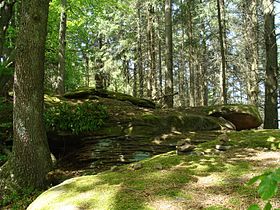Kesselberg (Palatinate)
| Kesselberg | |
|---|---|

Summit area of the Kesselberg
|
|
| Highest point | |
| Elevation | 661.8 m above sea level (NHN) (2,171 ft) |
| Coordinates | 49°17′04″N 8°02′42″E / 49.2845°N 8.0449°ECoordinates: 49°17′04″N 8°02′42″E / 49.2845°N 8.0449°E |
| Geography | |
|
|
|
| Parent range | Haardt (Palatine Forest) |
| Geology | |
| Mountain type | Bunter sandstone |
The Kesselberg near Edenkoben in the German state of Rhineland-Palatinate (Südliche Weinstraße county) is a mountain, 661.8 m above sea level (NHN), It iis second highest peak in the Palatine Forest region after the Kalmit (672.6 m) and also the third highest mountain in the Palatinate region (highest: Donnersberg 686.5 m).
The Kesselberg is located, like the Kalmit, in the mountain range of Haardt between the Edenkobener valley in the north and the Modenbach valley in the south. From the Rhine Plain the mountain is hidden behind the Blättersberg (618 m). Views over the surrounding regions in the Palatine Forest are blocked by the trees that cover the summit.
On the summit plateau are various rocks, named on hiking maps as the Gletschermulden, with striking round depressions in the Bunter sandstone of which they are composed. In addition to an unprovable theory that they were originally Celtic sacrifice bowls, there is also an theory that they are glacial potholes or mills. However, they would require a thick ice sheet to have covered the region and there is no evidence, such as glacial stria, anywhere in the Palatine region. It is thus questionable whether this could have been a periglacial site in the last ice age, as has been posited. A new interpretation suggests the depressions were simply formed by weathering processes in the various layers of sandstone.
...
Wikipedia

